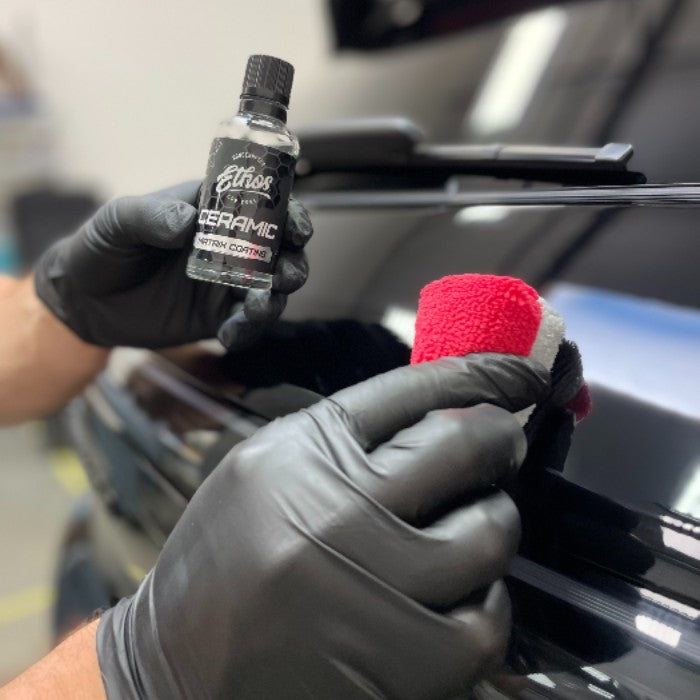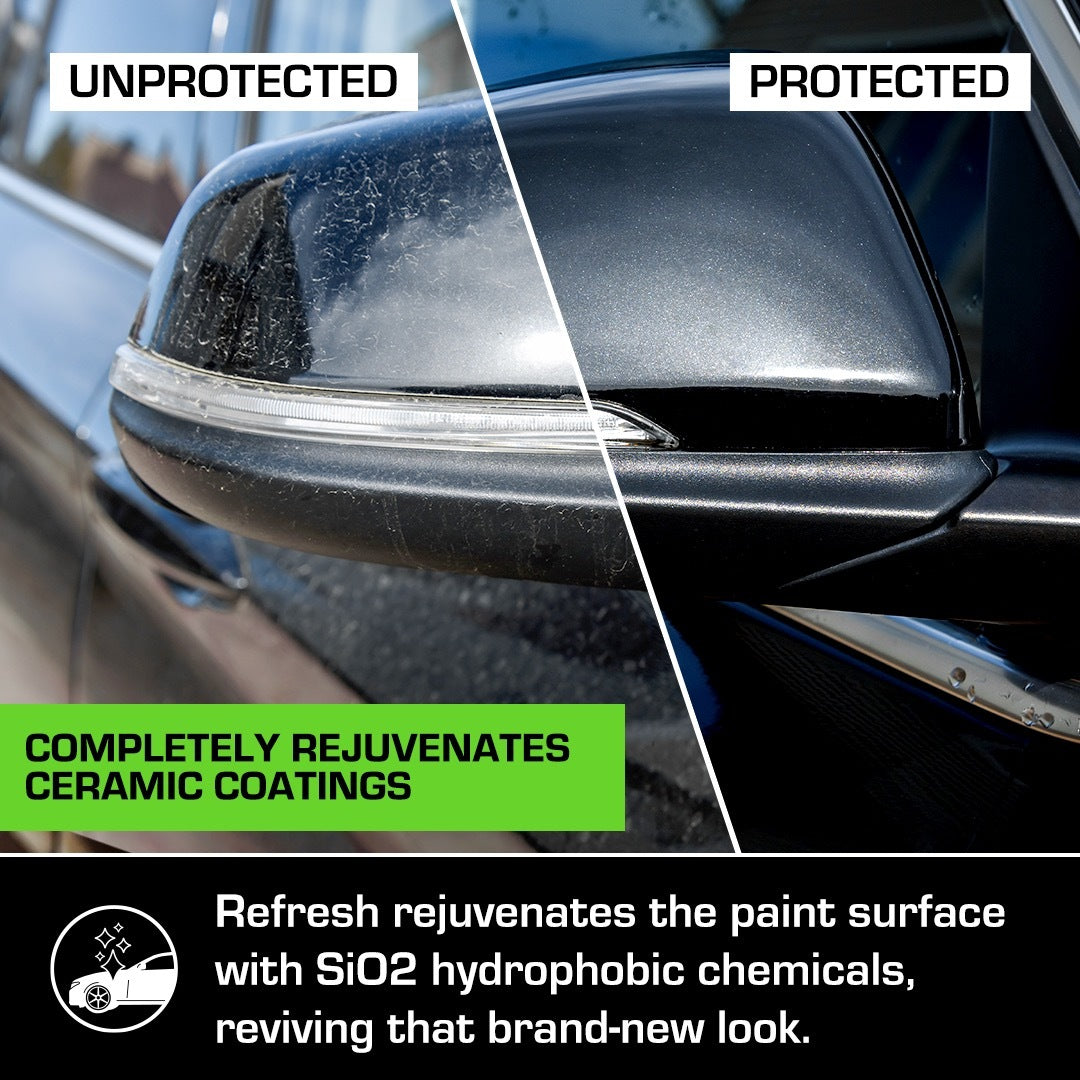Six common questions about Ceramic Coating Newark answered
Wiki Article
Checking out the Scientific Research Behind Car Ceramic Coating and Its Safety Properties
The scientific research of car ceramic coating provides a remarkable study in sophisticated automobile defense. Composed largely of silicon dioxide and polymers, these finishes form a robust bond with car paint. This communication enhances durability against ecological hazards while providing hydrophobic benefits. The details of just how these coatings job and their long-term advantages stay less understood. Ceramic Coating Newark. Unloading these information reveals why ceramic coverings are ending up being a preferred selection for car careWhat Is Ceramic Coating?
Ceramic coating is a liquid polymer that chemically bonds to the surface of a car's paint. This advanced protective layer enhances resilience and uses superior resistance to ecological factors. Unlike traditional wax or sealants, which give temporary security, ceramic layers develop a durable shield that can stand up to extreme problems such as UV rays, acidic contaminants, and extreme climate. When applied properly, the coating develops a hydrophobic surface, triggering water to grain and slide off, which assists in preserving the automobile's sanitation. Furthermore, it supplies boosted gloss and depth to the paint, making the automobile show up more sleek and vibrant. The application procedure usually includes thorough surface preparation, consisting of cleaning and polishing, to ensure peak bonding. Therefore, ceramic finishes are becoming increasingly prominent among car enthusiasts and those seeking to shield their investments, promising to keep the car's visual allure while minimizing the regularity of upkeep.The Make-up of Ceramic Coatings
The detailed solution of ceramic layers primarily includes silicon dioxide (SiO2), which is obtained from natural resources like quartz and sand. This vital part gives the foundation for the coating's durability and protective qualities. In addition to SiO2, ceramic layers usually consist of numerous polymers and ingredients that boost bond, versatility, and resistance to ecological factors. These compounds function synergistically to create a durable barrier versus contaminants such as dirt, chemicals, and UV rays.Furthermore, some formulations integrate titanium dioxide (TiO2) or other nanomaterials, which can enhance the coating's hydrophobic buildings, leading to better water repellency. The precise make-up can differ greatly among manufacturers, impacting efficiency and longevity. Eventually, the mix of these components finishes in a safety layer that not only enhances the aesthetic charm of automobiles but likewise serves to extend their lifespan by securing the surface from prospective damages.How Ceramic Coatings Job
Understanding exactly how ceramic coverings work involves exploring their chemical structure, which adds to their protective high qualities. The application procedure is necessary for achieving perfect results, while durability and toughness elements figure out the coating's performance gradually. Together, these elements highlight the benefits and performance of ceramic finishes for car security.Chemical Composition Explained
While numerous car owners look for resilient security for their cars, the chemical structure of ceramic coatings plays a vital role in their effectiveness. These coatings primarily consist of silicon dioxide (SiO2), which is derived from natural minerals. This substance creates a solid bond with the automobile's paint, developing a long lasting, safety layer. Furthermore, numerous ceramic finishes contain titanium dioxide (TiO2), improving their hydrophobic properties and resistance to UV rays. The presence of polysiloxanes can better boost flexibility and toughness. With each other, these elements add to the coating's capacity to fend off water, dust, and pollutants, while likewise offering a high-gloss surface. Recognizing this chemical foundation assists car proprietors value the robust defense provided by ceramic coverings.Application Refine Summary
Applying ceramic finishes involves a meticulous process that guarantees excellent bonding and defense for the vehicle's surface area. Originally, detailed cleansing and decontamination of the car's exterior are carried out to remove dirt, crud, and previous waxes. This step verifies that the surface area is cost-free from contaminations that can hinder adhesion. Following this, the paint is often brightened to improve quality and get rid of any blemishes. As soon as prepared, the ceramic coating is used in little sections making use of an applicator pad, enabling uniform coverage. The coating is after that left to heal, forming a strong chemical bond with the surface area. Correct healing times and conditions are crucial, as they validate the coating achieves its optimum efficiency and protective high qualities.Longevity and Resilience Aspects
Ceramic finishes are developed to offer long-lasting defense via their advanced chemical make-up, which produces a durable obstacle versus ecological impurities. The durability of these layers is influenced by elements such as the density of the application, the high quality of the item, and the conditions under which the lorry is subjected. High-grade ceramic finishes can last several years, withstanding scrapes, UV rays, and chemical stains. Appropriate maintenance, including normal cleaning and routine reapplication, can additionally boost longevity. Furthermore, ecological variables like environment and direct exposure to toxins can impact the lifespan of the coating. In general, when applied and kept appropriately, ceramic finishings supply exceptional resilience, making them a preferred choice for car lovers seeking to maintain their lorry's appearance.Hydrophobic Properties and Water Repellency
Hydrophobic homes are a characteristic of quality car ceramic coverings, significantly boosting the automobile's surface area efficiency. These finishes develop a molecular bond with the car's paint, resulting in a surface area that drives away water properly. When water enters into call with a ceramic-coated surface area, it grains up and rolls off, reducing the amount of liquid that stays on the paint. This actions not only adds to a visually pleasing look however additionally minimizes the build-up of pollutants such as dirt, grime, and road salts.The improved water repellency results in much easier cleansing and maintenance, as less initiative is called for to remove undesirable compounds. On top of that, the hydrophobic nature of ceramic coatings assists in stopping water areas, which can mar the coating of uncoated surface areas. In general, the unification of hydrophobic buildings in ceramic layers plays an essential function in keeping the vehicle's immaculate look while simplifying upkeep.Security Against Scratches and UV Damages
Car ceramic coverings supply considerable defense against scratches and UV damages. The scrape resistance mechanism produces browse around here a resilient layer that absorbs impacts, while the UV shielding benefits help keep the vehicle's paint honesty gradually. Together, these attributes contribute to a longer-lasting and aesthetically enticing coating.Scratch Resistance Mechanism
Making use of innovative innovation, ceramic finishings provide a durable shield against scratches and UV damage, enhancing the longevity and appearance of lorry surface areas. The scratch resistance mechanism of these coatings is credited to their distinct molecular structure, which creates a resilient bond with the automobile's paint. This bond develops a hard, safety layer that can take in influences and resist abrasions. In addition, the smooth surface area of the coating minimizes friction, making it challenging for contaminants to adhere and create scratches. The chemical structure of ceramic coverings frequently consists of nanoparticles that strengthen the safety layer, additional enhancing its durability. Vehicles treated with ceramic finishes display noticeably boosted scrape resistance compared to typical wax or sealants, making certain an excellent finish over time.UV Protecting Benefits
The protective qualities of ceramic coverings expand past scratch resistance to consist of significant UV protecting advantages. These coverings develop a robust barrier that shows dangerous ultraviolet rays, securing the lorry's paint and underlying products. Extended direct exposure to UV radiation can lead to fading, oxidation, and wear and tear of the paint surface. By incorporating ceramic website link coverings, lorry proprietors can effectively mitigate these threats, maintaining the aesthetic charm and honesty of their vehicles. In addition, the UV blocking residential or commercial properties contribute to boosted durability, lowering the regularity of repainting and upkeep. Inevitably, the integration of ceramic finishes uses a complete remedy for securing lorries from the destructive effects of sunlight exposure, guaranteeing a sustained, dynamic look with time.The Long life and Upkeep of Ceramic Coatings

Often Asked Concerns
Can Ceramic Coating Be Applied to Any Kind Of Automobile?
Ceramic coating can be put on numerous sorts of lorries, including vehicles, vehicles, and motorcycles. Surface area prep work and compatibility with certain products are crucial for ideal adhesion and efficiency of the coating.Just How Much Does Ceramic Coating Normally Expense?
Ceramic coating typically sets you back in between $500 and $2,000, depending on factors such as car size, coating quality, and expert application. The investment can give lasting defense and boost the lorry's appearance over time.
Is Specialist Application Necessary for Finest Outcomes?
The requirement of professional application usually depends on desired outcomes. Specialists commonly assure proper surface preparation and application strategies, bring about excellent bonding and durability of the coating, which may be testing for unskilled individuals to achieve.Can Ceramic Coatings Be Gotten Rid Of or Repaired?
Ceramic coverings can look at more info be gotten rid of or repaired, though the procedure might require certain solvents or methods - Ceramic Coating Newark. Correct elimination is vital to stay clear of damages to the underlying surface, emphasizing the importance of specialist support for optimal outcomesJust How Does Ceramic Coating Contrast to Typical Wax?
The comparison in between ceramic coating and traditional wax discloses that ceramic finishings supply superior resilience, boosted defense against ecological pollutants, and longer-lasting luster, while wax requires a lot more frequent application and supplies much less overall resistance to damages.Report this wiki page